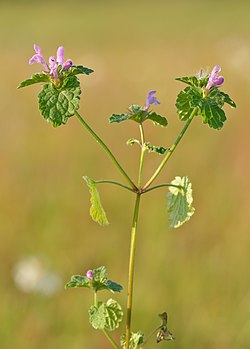Lamium
Genus of flowering plants From Wikipedia, the free encyclopedia
Lamium (dead-nettles) is a genus of about 30 species of flowering plants in the family Lamiaceae, of which it is the type genus. They are all herbaceous plants native to Eurasia and northern Africa, with several widely naturalised across much of the temperate world.
| Lamium | |
|---|---|
 | |
| Lamium amplexicaule | |
| Scientific classification | |
| Kingdom: | Plantae |
| Clade: | Tracheophytes |
| Clade: | Angiosperms |
| Clade: | Eudicots |
| Clade: | Asterids |
| Order: | Lamiales |
| Family: | Lamiaceae |
| Subfamily: | Lamioideae |
| Genus: | Lamium L.[1] |
| Type species | |
| Lamium purpureum L. | |
| Synonyms[2] | |
| |
Description
The genus includes both annual and perennial species; they spread by both seeds and stems rooting as they grow along the ground. They have square stems[3] and coarsely textured pairs of leaves, often with striking patterns or variegation. They produce double-lipped flowers in a wide range of colours.[4]
Taxonomy
Summarize
Perspective
In volume 2 of Species Plantarum published in 1753, the Swedish botanist Carl Linnaeus established genus Lamium by recognizing four species: Lamium album, Lamium purpureum, Lamium amplexicaule, and Lamium multifidum.[5][6] The name Lamium L. is the primary generic name in use today.[2][7]
As of May 2024[update], Plants of the World Online accepts the following species:[2]
- Lamium album L. – (white dead-nettle) – widespread across Europe + northern Asia from Spain + Norway to Japan + Kamchatka; naturalised in New Zealand + North America
- Lamium amplexicaule L. – (henbit dead-nettle) – widespread across Europe and northern Asia from Spain + Norway to Japan + Kamchatka, as well as North Africa, Ethiopia, Azores, Madeira, Canary Islands; naturalised in New Zealand, Hawaii, South America + North America
- Lamium bakhtiaricum Jamzad – Iran
- Lamium bifidum Cirillo – Mediterranean from Portugal to Romania
- Lamium bilgilii Celep – Turkey
- Lamium cappadocicum Celep & Karaer – Turkey
- Lamium caucasicum Grossh. – Caucasus (southern European Russia, Armenia, Georgia, Azerbaijan)
- Lamium confertum Fr. – (northern dead-nettle) – northern Europe from Ireland to northern Russia; naturalised in Greenland + Iceland
- Lamium coutinhoi J.G.García – Portugal
- Lamium cyrneum Paradis – Corsica
- Lamium demirizii A.P.Khokhr. – Turkey
- Lamium eriocephalum Benth. – Turkey
- Lamium flexuosum Ten. – Spain, France, Italy, Algeria, Morocco, Tunisia
- Lamium galactophyllum Boiss. & Reut. – Turkey
- Lamium galeobdolon (L.) L. – (yellow archangel) – northern + central Europe and western Asia from Spain + Denmark east to Iran + Western Siberia; naturalised in North America, New Zealand, Madeira
- Lamium garganicum L. – Mediterranean + western Asia from Portugal to Kazakhstan + Saudi Arabia
- Lamium gevorense (Gómez Hern.) Gómez Hern. & A.Pujadas – Spain, Portugal, Corsica
- Lamium glaberrimum (K.Koch) Taliev – Crimea
- Lamium × holsaticum Prahl – central Europe (L. album × L. maculatum)
- Lamium hybridum Vill. – (cut-leaved dead-nettle) – Europe, Macaronesia, North Africa
- Lamium macrodon Boiss. & A.Huet – Turkey, Caucasus, Syria, Iran, Iraq
- Lamium maculatum L. – (spotted dead-nettle) – Europe + Middle East from Portugal to Turkey; also Gansu + Xinjiang Provinces of western China
- Lamium moschatum Mill. – eastern Mediterranean (Greece, Turkey, Syria, Palestine, Cyprus)
- Lamium multifidum L. – Turkey, Caucasus
- Lamium orientale (Fisch. & C.A.Mey.) E.H.L.Krause – Turkey, Syria, Palestine
- Lamium orvala L. – Austria, Italy, Hungary, Slovenia
- Lamium purpureum L. (red dead-nettle) – northern + central Europe and western Asia from Spain + Denmark east to Caucasus + Siberia; naturalised in Korea, Taiwan, North America, New Zealand, Argentina, Falkland Islands
- Lamium taiwanense S.S.Ying – Taiwan
- Lamium × schroeteri Gams – France, Switzerland, Hungary
- Lamium tomentosum Willd. – Turkey, Caucasus, Iran, Iraq
- Lamium tschorochense A.P.Khokhr. – Turkey
- Lamium vreemanii A.P.Khokhr. – Turkey
Several closely related genera were formerly included in Lamium by some botanists, including Galeopsis (hemp-nettles) and Leonurus (motherworts).[citation needed]
Etymology
The generic name Lamium was used by Pliny the Elder in the first century AD.[8][9] The name comes from the Greek laimos, which means "gullet", a reference to the gaping throat-like appearance of the corolla.[10]
The common name "dead-nettle" has been derived from the German Taubnessel ("deaf nettle", or "nettle without a kernel"),[11] and refers to the resemblance of Lamium album[12] to the very distantly related stinging nettles, but unlike those, they do not have stinging hairs and so are harmless or apparently "dead".
Distribution and habitat
The species are native to Europe, Asia. and northern Africa, but several have become very successful weeds of crop fields and are now widely naturalised across much of the temperate world.[13][14]
Ecology

Lamium species are used as food plants by the larvae of some Lepidoptera species including angle shades, setaceous Hebrew character and the Coleophora case-bearers C. ballotella, C. lineolea and C. ochripennella.
Cultivation
Lamium species are widely cultivated as groundcover, and numerous cultivars have been selected for garden use.[4] They are frost hardy and grow well in most soils. Flower colour determines planting season and light requirement: white- and purple-coloured flowered species are planted in spring and prefer full sun. The yellow-flowered ones are planted in fall (autumn) and prefer shade. They often have invasive habits and need plenty of room.
References
Bibliography
Wikiwand - on
Seamless Wikipedia browsing. On steroids.
